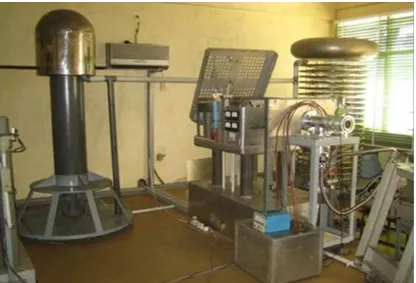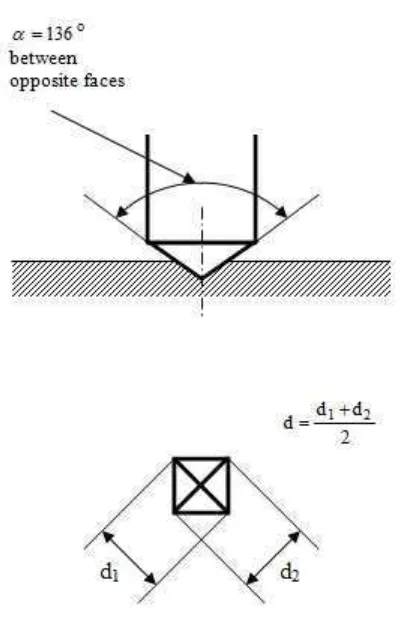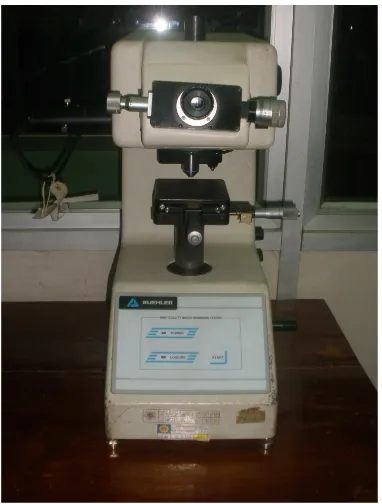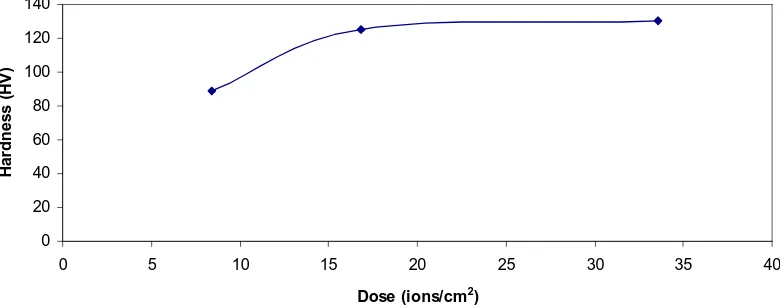M-18
THE INFLUENCES OF ION IMPLANTATION DOSES TO
COMMERCIALLY PURE TITANIUM SURFACE HARDNESS
Agung Setyo Darmawan
1, Waluyo Adi Siswanto
2, Bambang Waluyo Febrianto
1,
and Tjipto Sujitno
31Jurusan Teknik Mesin, Universitas Muhammadiyah Surakarta (UMS),
Pabelan, Surakarta 57102, Indonesia.
2
Department of Engineering Mechanics, Universiti Tun Hussein Onn Malaysia, 86400 Parit Raja, Batu Pahat, Johor, Malaysia
3National Nuclear Energy Agency (BATAN), Yogyakarta 55281, Indonesia
Email: [email protected]
Abstract.
Commercially pure (cp) titanium has a relative soft hardness property. In particular usage such as sliding, the improvement of the hardness value will be required. To improve the hardness of the surface while maintaining the original properties, ion implantation process is conducted. Nitrogen ions are used to implant this material. The effects of the nitrogen ion doses to the surface hardness are then studied. In this study, Ion Implantation processes are conducted at room temperature and process durations are varied as 140 minutes, 280 minutes and 560 minutes. The doses of nitrogen ions which is required in these process durations are 8.4x1014 ions/cm2, 16.8x1014 ions/cm2, and 33.6x1014 ions/cm2 respectively. Hardness tests are then performed on each specimen by using Micro Vickers Hardness Tester. The processes of ion implantation produce the hardness surface values of 88.97 HV, 125.51 HV, and 130.2 HV, for the doses of 8.4x1014 ions/cm2, 16.8x1014 ions/cm2, and 33.6x1014 ions/cm2. The ion implantation of cp titanium can significantly increase the hardness on the surface. Compared to the hardness of the raw material, these processes have increased the hardness values by 64.8 %, 132.5 %, and 141.2 % for the doses of 8.4x1014 ions/cm2, 16.8x1014 ions/cm2, and 33.6x1014 ions/cm2 respectively. The hardness can be improved as high as 41.07 % when the dose is increased from 8.4x1014 ions/cm2 to 16.8x1014 ions/cm2. However there is no a significant increasing in hardness value when the dose is increased from 16.8x1014 ions/cm2 to 33.6x1014 ions/cm2.
Keywords: diffusion; hardness; implant material; surface hardening; vickers
Introduction
Ion implantation is a special case of particle radiation. The process involves the bombardment of a solid material with medium to high energy ionized atoms into the near surface region of any substrate. This near surface alloying can be performed irrespective of thermodynamic criteria such as solubility and diffusivity. These advantages, coupled with the additional possibility of low-temperature processing, have prompted explorations into applications in which the limitations of dimensional changes and possible delaminating of conventional coatings are a concern (Hirvonen and Sartwell, 1994). Component dimensions or bulk material properties are not adversely affected by the process.
A schematic view of the path of an individual ion in ion implantation is shown in Figure 1. The individual ion is loses its energy and create a shallow surface-modified region. As illustrated in the figure, the ion does not travel in a straight path to its resting place, due to collisions with the target atoms. Target atoms are displaced from their lattice sites with sufficient energy that they can themselves displace additional target atoms, resulting in a collision cascade.
Ion implantation equipment typically consists of an ion source, where ions of the desired element are produced, an accelerator, where the ions are electrostatically accelerated to a high energy, and a target chamber, where the ions impinge on a target, which is the material to be implanted. The schematic of equipment setup and photograph of the device arrangement for plasma nitrocarburizing can be seen in Figure 2 and Figure 3, respectively.
M-19
Figure 1: A schematic view of the path of an individual ion in ion implantation (Hirvonen and Sartwell, 1994).
M-20
Several researchers have utilized the ion implantation applications in the medical area, such as for orthopaedic prostheses that require high wear properties, excellent corrosion resistance and biocompatibility (Diaz et al., 2009; Jagielski et al., 2006; Huang et al., 2004).
The titanium alloy Ti–6Al–4V is widely in use for biomedical applications such as artificial hip and knee joints. Beneficial properties include improved ductility, tensile and fatigue strength, bone-matched modulus of elasticity and biocompatibility due to the native oxide layer (Torregrosa et al., 1995; Tsyganov et al., 2002). However, there are some concerns about the toxicity of Al and V wear debris in the human body that might negative side effects to the human body. For this reason, the use of cp titanium is a potential metal and safer to replace Ti-6Al-4V titanium alloy bearings. But, its wear properties still need to be improved (Darmawan et al., 2010).
It is generally known that ion implantation treatment can improve the mechanical wear properties of metals. In particular, nitrogen ion implantation is an excellent process to enhance the wear resistance of a wide range of ferrous materials and titanium-based alloys (Ikeda et al., 2002).
Improvement of the surface hardness and corrosion resistance are depended on the used of implantation parameters such as energy, dose or time. The dose,φ, is related to the beam current, I, by the following formula (Nastasi and Mayer, 2006):
qiA
It
=
φ
(1)Where,
t: implantation time A: beam area qi: the charge per ion
Beam current and implantation doses typically range from 1 µA – 30 mA and 1011 – 1019 atoms/cm2
In this study, the effects of the nitrogen ion doses to the surface hardness are then investigated. The surface hardness is measured by using Micro Vickers Hardness Tester.
Figure 3: Photograph of the device arrangement for ion implantation Materials and Methods
M-21
Regarding to ion implantation processes, cp titanium material is cut with the size of 1 cm x 1 cm x 0.3 cm. Specimens as many as three pieces created for this purpose. Then the material is grinded and polished using polycrystalline diamond until it is clean and shiny.
The ion implantation process is conducted by the ion implantor 200 kV/ 2mA. Nitrogen ion is implanted in target chamber of ICS-SP 1104. The energy of 100 keV and the current of 100 ηA are applied. During ion implantation, the vacuum at the target chamber was maintained below 1x10-6 mBar. In this study, process durations are varied as 140 minutes, 280 minutes and 560 minutes.
Prior to hardness testing, a careful surface preparation (grinding and polishing) is conducted to ensure a well-defined indentation that may be accurately measured. This hardness test follows the standard ASTM E 384. The micro-hardness measurement works with indenter force as light as 10 gf (gram force), with indentation time in 15 seconds. The indenter is a square-based pyramidal-shaped diamond with a face angle of 136°. This indenter and its diagonals of impression are illustrated in Figure 4. After force removal, the impression diagonals are measured with a light microscope. It is assumed that the indentation does not undergo elastic recovery after force removal.
Figure 4: Vickers Hardness Test
The Vickers hardness number can be determined by the following equation:
2
/ 854 ,
1 P d
HV = (2)
where
P: the applied force (Kg),
d: mean diagonal of impression (mm).
Karl Frank GMBH Type 38505 micro hardness tester is used for measuring the hardness of the specimen. This micro hardness tester can be seen in Figure 5.
Results and Discussions
M-22
Doses Calculation for Ion Implantation: Using Eq.1, the dose required for ion implantation is calculated for each duration process. For example, the dose calculation for beam current, I = 100 Aη , implantation time, t = 140
Similarly, the dose required is calculated, the result can be seen in table 1.
Fig. 5: Karl Frank GMBH Type 38505 Buehler Micro hardness tester Table 1 Result of dose calculation for various duration
Duration
Surface hardness calculation: After the specimens are ion implantation processed, hardness testing is conducted on the surface of the specimens. Using Eq.2, the surface hardness is calculated for each duration process. Then the results can be seen in table 2.
M-23
125.51 HV, and 130.2 HV, respectively. Compared to the hardness of the raw material, these processes have increased the hardness values by 64.8 %, 132.5 %, and 141.2 % respectively.
There is a significant increased in hardness value when the dose is increased from 8.4x1014 ions/cm2 to 16.8x1014 ions/cm2. The hardness can be improved as high as 41.07%.
The hardness improvement, however does not show a linear behavior when the dose is increased. When the dose is increased to 33.6x1014 ions/cm2, the hardness value is increased only 3.74%. The hardness improvement is not significant when it is compared with that of dose increasing from 8.4x1014 ions/cm2 to 16.8x1014 ions/cm2. The hardness values are illustrated in Figure 6.
0
Figure 6: The hardness values in the surface of specimen which is processed ion implantation.
The results of ion implantation test showed the longer the duration the higher the value of the resulting hardness. This is because the longer the process duration the greater the number of nitrogen ions diffuse into the surface of titanium (see again table 1) so the greater the number of TiN compound is formed on the surface.
Conclusions
In this research, the surface hardness of cp titanium is modified and improved by using ion implantation process. The effects of such processes to hardness value can be concluded as the followings:
1. The ion implantation of cp titanium can significantly increase the hardness on the surface.
2. Compared to the hardness of the raw material, these processes have increased the hardness values by 64.8 %, 132.5 %, and 141.2 % for the doses of 8.4x1014 ions/cm2, 16.8x1014 ions/cm2, and 33.6x1014 ions/cm2
The authors gratefully acknowledge financial support from Universiti Tun Hussein Onn Malaysia under Fund Scheme GIS Vot 0809. The authors also would like to thank Accelerator Application Group of BATAN-Yogyakarta Indonesia for allowing ion implantation processes be conducted in its laboratory; Material Laboratory of Universitas Gajah Mada Indonesia for micro Vickers hardness test and Mechanical Engineering Laboratory of Universitas Muhammadiyah Surakarta for all specimens preparation.
References:
Darmawan, A. S., Siswanto, A. S. and Samekto, H., (2010), “Effect of Femoral Head Size to Contact Stress at Pure Titanium Femoral Ball Head Outer Surface of Hip Joint Implant”, Proceeding of National Conference on Advanced Manufacturing and Materials, Universiti Tun Hussein Onn Malaysia, Malaysia, pp. 18
Díaz, C., Lutz, J., Mändl, S., García, J.A., Martínez, R., and Rodríguez, R. J., (2009), “Improved bio-tribology of biomedical alloys by ion implantation techniques”, Nuclear Instruments and Methods in Physics Research, Vol. B 267, pp. 1630–1633
M-24
Huang, N., Yang, P., Leng, Y. X., Wang, J., Sun, H., Chen, J. Y., and Wan, G. J., (2004), “Surface modification of biomaterials by plasma immersion ion implantation”, Surface & Coatings Technology, Vol. 186, pp. 218– 226
Ikeda, D., Ogawa, M., Hara, Y., Nishimura, Y., Odusanya, O., Azuma, K., Matsuda, S., Yatsuzuka, M., and Murakami, A., (2002), “Effect of nitrogen plasma-based ion implantation on joint prosthetic material”, Surface and Coatings Technology, Vol. 156, pp. 301–305
Jagielski, J., Piatkowska, A., Aubert, P., Thomé, L., Turos, A., and Kader, A. A., (2006), “Ion implantation for surface modification of biomaterials”, Surface & Coatings Technology, Vol. 200, pp. 6355–6361
Nastasi, M., and Mayer, J. W., (2006), “Ion Implantation and Synthesis of Materials”, Springer, Berlin, German, Torregrosa, F., Barrallier, L., and Roux, L., (1995), “Phase analysis, microhardness and tribological behaviour of
Ti-6A1-4V after ion implantation of nitrogen in connection with its application for hip-joint prosthesis”, Thin Solid Films, Vol. 266, pp. 245-253



